Life has never been all about cricket for Australia’s new men’s Test captain. And given the job Pat Cummins has walked into, and the fate of his predecessors, that could be his saving grace.
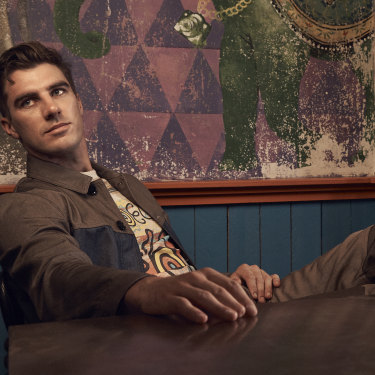
At school, Pat Cummins was part of the “sporty geeky” group, and now has a business degree – a departure from recent sports-mad Test cricket captains.Credit:Damian Bennett
Kings Cross, October 2013. Sydney’s nightlife district is entering its final summer before the introduction of the 1.30am lockout laws. Late on this Sunday evening, there’s not a whole lot going on. In the bar of Kit and Kaboodle, a club upstairs from what was then known as The Sugarmill, a smattering of 20-somethings are trying to keep the weekend going.
Two are bar staff who work in the CBD, making the most of their “hospo night” before shifts resume. One of the other two is a 20-year-old fast bowler named Patrick Cummins. As he explains to Good Weekend, it wasn’t just youth and spare time that had him out on the town that night.
“I’d just been told I had stress fractures again, so I was pretty dirty,” he says. “I’ve been to Kings Cross just a couple of times in my life, and I happened to go on that Sunday night, and it was dead quiet.” Quiet enough for Cummins and his friend to get talking to the only other two people in the bar. “It was people who really should have been going to bed. Becky got dragged there, that’s the only time she’s ever been to the Cross basically, and I went, too, and yeah …”
Becky was Rebecca Boston, a 22-year-old from Harrogate in England who was in Australia on a working holiday visa. The conversation continued over a shared meal at McDonald’s on Darlinghurst Road, and resumed the next day with an invitation from Pat to Becky to come to a barbecue.
Eight years later, Pat and Becky are engaged. They welcomed their first child, Albie, into the world in October, only days before Cummins flew to the UAE to begin a summer that climaxes with a home Ashes series kicking off next week.
This is an important story in the life of Pat Cummins, who at 28 is the first fast bowler in more than half a century to be named captain of the Australian men’s cricket team. (The last was Ray Lindwall, who captained for a single Test in 1956.) Cummins was considered the man most likely for most of 2021, with Tim Paine expected to retire when the Ashes ends in January. That plan was rushed forward mid-last month, however, when a 2018 sexual harassment complaint against Paine hit the headlines, forcing the wicketkeeper’s resignation as Australia’s 46th Test captain.
But what’s the connection between a night out in the old Kings Cross and the leadership machinations of Australian cricket in 2021? It comes through in the context in which Cummins framed his early conversations with Becky, and the way he sees himself. “The first couple of times I met Becky I told her I was a uni student because, technically, I was [at the University of Technology, Sydney],” he says. “I left out the cricket part. Then one day, a few weeks after we started dating, she walked past a KFC in the city, and on the front was me wearing a bucket hat. She reckons she did a double take and was like, ‘Hang on, that’s Pat.’ ”
Becky takes up the story. “I knew straight away it was Pat and related to some kind of sport, and when I got to my shift at work, I asked the girls, and they had to explain to me that he played cricket. I thought it was pretty cool, but I was very confused, and I had a lot of questions after that! I didn’t know anything about cricket, so it was an eye-opener …”
Cummins, then, is a cricketer. But that is far from the only thing he wants to be. And after nearly 25 years of a fully professional system in Australian cricket – where the ball-tampering and Paine scandals suggest perspective from beyond the sport is sorely needed – this can only be good for the national men’s captaincy.
“Some parts of it are daunting, but you can’t stay in bed all day worrying about some of these things,” Cummins says of his new responsibilities. “There’s so much positive to this role, there’s so much I could bring to it. I’ll try not to overthink it. I’ll be myself and hopefully that’s enough.”
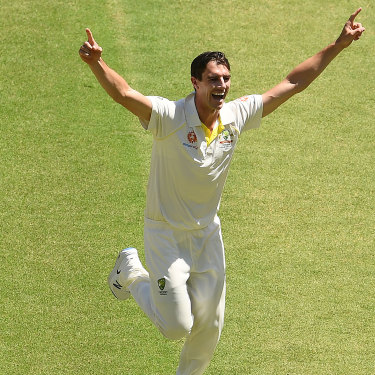
Cummins doesn’t like problems festering. “I don’t want to spend 70 per cent of my life on tour in an environment I’m not comfortable with.” Credit:Getty Images
I first met Cummins at the SCG shortly after his return from South Africa in 2011, where his Test debut marked only his fourth first-class match. He’s always been sunny and friendly, if a little mannered in his modesty, conscious he’s being interviewed. Take him away from the here and now, however, and you find the man behind the cricketer.
Today we’re talking via Zoom, Cummins from quarantine in Abu Dhabi, ahead of the Australian team’s victorious T20 World Cup campaign last month. He’s let a few days’ stubble grow, even if he is sticking to a rigorous personal training regimen to stay limber. His face lights up when I tell him we’re going back to his childhood – as far as it is possible to be from a hotel room.
“No balls in the house” was the instruction that echoed through the family home in NSW’s Blue Mountains, west of Sydney. Cummins’ father, Peter, was an accountant who later ran a sand quarry and remains obsessed with Bruce Springsteen. His mother, Maria, was a maths teacher who endured breast cancer while Cummins was at primary school. As one of five children, Cummins was never short of sporting partners, either competitive footy and cricket with his older brothers Matt and Tim, or netball with Maria and his sisters Laura and Kara.
Aged 14, he was invited to a state representative soccer tryout, but missed a Monday night episode of Malcolm in the Middle to do so. “I remember just thinking, ‘That wasn’t worth it, I won’t do that again.’ ”
Cricket was Peter Cummins’ favourite sport, the background noise of family summers. Since they did not have Foxtel, news that SBS had free-to-air rights to the 2005 Ashes series caused a momentary panic due to its spotty reception in the Blue Mountains. Until, that is, Peter came through with a solution – a new, SBS-friendly antenna. Other overseas tours were followed via the Cricinfo website: “One of the brothers or Dad would shout out the score every half an hour.”
At the co-ed St Paul’s Grammar in Cranebrook, Cummins was sporty but not a jock. “The sporty, geeky-type group,” he says when asked to describe his high school crowd. “St Paul’s wasn’t really sporty at all. The running joke was if you owned a cricket bat you could be in the school team.”
To his mates, Cummins was a gifted cricketer, but not excessively so. Nor did he spend every waking moment bowling or hitting balls. So when he let them know he was to make his debut for NSW in January 2011, still aged 17, there was genuine surprise. “They all came to the first couple of NSW games and they were like, ‘We didn’t know you were even close to this a month ago’, and I said, ‘Well, neither did I, really.’ ”
Here it’s worth recalling the early days of Australia’s recent men’s Test captains. Ricky Ponting signed a bat contract with Kookaburra aged 14. Michael Clarke’s parents owned an indoor cricket centre, where he spent countless hours playing and training before his first-grade debut at 16. Steve Smith, accompanied by his under-age coach and a Cricket NSW welfare officer, fronted the principal of Menai High School to quit his studies early in year 12. And Tim Paine was barely 16 when contracted by Tasmania. The perspective for which Paine has been lauded only came years later, when a serious finger fracture forced him to the fringes of the professional game and to ponder getting a real job. Even then, his unexpected recall to the Test team contributed to ego-driven trouble of its own.
For Cummins, though he made his Test debut earlier than any of the above quartet, cricket was never his idea of a career path until well after it became one. “I knew I needed a proper job, and honestly never did I think that cricket was a career,” he says. “It was only when I got a Cricket Australia contract [in June 2011, less than a month after his 18th birthday] that I thought, ‘Oh my god, I’m actually a professional cricketer here.’ ”
Big difference.
Geoff Lawson, a visionary former fast bowler who qualified as an optometrist before serving as NSW captain, has seen Cummins’ outlook up close. From behind the state dressing room door, he knew a stand-out captain in the making – reminiscent of the semi-professional era – when he saw one.
“It’s a bit of a catch-22,” Lawson says. “The smarter ones know they need a broader outlook on life, so they get it. The not-so-smart ones don’t, so all they do is hit balls as per Ponting, Clarke and Smith. ‘I hit a thousand balls today’ – that’s their big thing. Too many of the next-level and younger players think that’s what they’ve got to do, and don’t worry about the rest of their lives, until cricket might not actually turn out for them.”
As well-adjusted as Cummins may be, he will face myriad challenges in a role where, judging by his two predecessors, the better his image, the further he has to fall. Is he durable enough? Does he galvanise the team? Can he lead from the balcony if injured or rested? Will he want to do it for long once he finds out what it’s like? Cummins, and Australia, are about to find out.
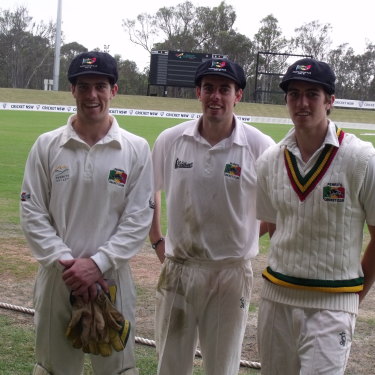
Pat (at right) with his brothers Matt and Tim in 2010.Credit:Courtesy of the Cummins Family
Intelligence, a breadth of thinking and a good education were all going to help Cummins become a cricketer of substance, but they were not the defining characteristics to make it so. Sheer pace, at a very young age, was, however.
When did he first realise he was fast? “There was this one guy in junior cricket, every time I played him I hit him, and he retired hurt three times in three years. His mum came up to me, pleading, ‘Please stop hurting my little boy,’ and I was like, ‘I’m sorry, I’m not meaning to hit him,’ but in the back of my mind I’m thinking, ‘Well, he’s allowed to retire, kick his stumps over, this is serious stuff.’ So I didn’t have a lot of sympathy!”
Peter Cummins, still without Foxtel, took his sons to a nearby pub to watch a T20 Big Bash game in December 2010. “As a cocky little 17-year-old, I was thinking, ‘I reckon I could play this,’ ” Pat Cummins recalls. “I don’t know where that came from. But within a couple of weeks I got the chance to debut because there were a few injuries. Stuart Clark captained us that season and he really looked after me. I remember feeling like I didn’t belong there.”
The speed of Cummins’ rise must have given him something like imposter syndrome – except for when he actually had the ball. “That’s a great way to put it,” he says. “Once I got the ball in my hand, it’s the little brother in me that’s always been trying to compete against my older brothers no matter what, and there are no handicaps.”
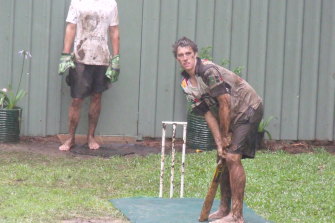
Pat bats during a muddy game in the Cummins family’s backyard.Credit:Courtesy of the Cummins Family
Two images of Cummins stand out from an early Sheffield Shield game at the Sydney Cricket Ground against Western Australia. The first is of how terrifyingly fast he can bowl – at about 150 kilometres per hour – epitomised by the fact he “badged” the Test batter Marcus North (hit him on his helmet’s insignia). This was a feat so rare that a West Australian teammate brought North’s helmet into the NSW rooms for Cummins to impishly sign. He wrote, “Keep your eye on the ball youngster!” North still has the helmet.
During his first Sheffield Shield game at the SCG, Cummins drove mum Maria’s car into the ground each morning, with her in the passenger seat, before she drove it home through the day and then returned after play. Before commencing the two-hour return journey with Maria, Cummins reattached his P plates to the front and rear. He recalls being offered a dressing-room beer and thinking, “I’m 17, and I’ve got to drive home …”
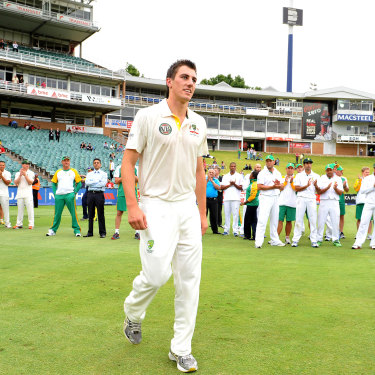
Cummins winning the man of the match award on his Test debut, against South Africa in 2011.Credit:Getty Images
Cummins’ Test debut in South Africa in 2011 remains legendary, not least because he hit the winning runs. As an 18-year-old overseas without his parents for the first time, he had the month of his life. A close friendship was formed with Mitch Marsh, the other young member of the touring squad, while nightly dinners with the likes of Shane Watson and Mike Hussey left him asking more questions than he ever had at school.
The first Test in Cape Town famously twisted about six ways in a couple of hours, bewildering everyone. But on debut in the second Test of the series, in Johannesburg in November 2011, Cummins retained the calm and confidence he’d displayed for his state. “This might sound disrespectful, but I remember looking from afar and thinking, ‘Wow, these guys are super-heroes,’ then when I played alongside them I thought, ‘Well, they’re not doing anything I can’t do.’ I felt that really quickly.”
How, then, did the 18-year-old get to understand the Australian team dressing room, with all its personalities, histories and pressures? “Chris Hadfield, in his book An Astronaut’s Guide to Life on Earth, had the idea that if you go into a new environment, you don’t have to be a ‘plus one’ addition to start with, just be a zero. So even if you’re at the top of your game and have been brought into a new role, you just have to do no damage, get the lie of the land, and be passive for a while because you and everyone else will learn the right rhythm. That’s always been me.”
Initially, the foot stress injury Cummins brought home from South Africa did not seem a huge issue. He was still part of the build-up to the home summer, and promotions for the first season of the Big Bash League. On opening night at the SCG, he was a jovial presence at the Cricket Australia function in the Victor Trumper Stand, and by mid-next year he was back in the white-ball team in the UK.
“This might sound disrespectful, but I remember looking from afar and thinking, ‘Wow, these guys are super-heroes,’ then when I played alongside them I thought, ‘Well, they’re not doing anything I can’t do.’”
But then problems mounted: a side strain, followed by a second back stress fracture, then a third – the one he was dealing with when he met Becky. There was, as recounted by some Cricket Australia and Cricket NSW fitness and medical staff, a constant tension between Cummins’ prodigious ability and the need for him to be patient with his body, termed a “Ferrari engine in a Corolla chassis” by one physio.
What helped Cummins was his enrolment at the University of Technology Sydney, to study business and marketing. Not just for the subjects, but for the maintenance of normality, the continuation of friendships, and the navigation of young adult tasks like figuring out which trains to catch, how to enrol in subjects, where to go for beers after lectures: North Sydney’s Greenwood on a Thursday night. “Uni was a place of comfort with people who had known me for a long time and didn’t really care if I did well in cricket,” he says.
“I’d signed up [at 17] before I knew cricket was going to take off, and part of it was an insecurity of still feeling unproven. As stupid as it sounds, I remember the ACA [Australian Cricketers’ Association] helping to chip in and pay for uni, and I thought, ‘What a deal, they’re saving me a couple of grand here, I’d be an idiot not to.’ ”
Justine Whipper, formerly the personal development manager at Cricket NSW and now in an overarching role for the ACA, says the way Cummins built wider interests is now a much greater part of player education than a decade ago. “If you’re not doing anything outside of cricket, well your future is completely up to everybody else,” she says. “But if you start to develop yourself and explore, then that becomes under your control.”
One physio termed Cummins’ injury-prone body a “Ferrari engine in a Corolla chassis”.
Once Becky arrived on the scene, it was she who spent more time away, back with her family in the UK. The relationship grew more organically than most in international cricket: picture an early-20s montage of house renovations, beach time at Sydney’s Clovelly, barbecues and beer gardens. Whenever possible, the couple escape to a farm they own in the NSW Southern Highlands: it was there in February 2020 that Cummins proposed.
“More than anything, just the normality of routine together is what I loved the most and still love the most,” he says. “What’s the quote, ‘You don’t miss doing something with someone, you miss doing nothing with someone’? That rings true.
“In some ways I had hoped that it might be the calm before the storm. These might be the quiet years – and if everything goes well and I’m away, we might not experience this for a long time.”
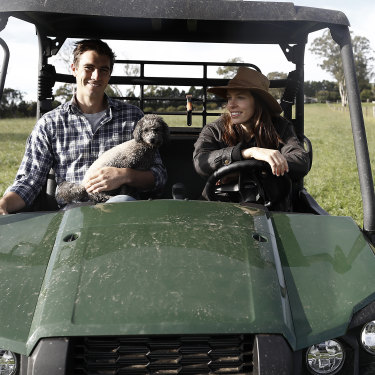
Cummins, fiancée Becky Boston and Norman the dog at the couple’s NSW Southern Highlands farm, to which they escape whenever possible.Credit:Getty Images
Ever since he first picked up Harry Potter as a child, Cummins has been a voracious reader. He balances fiction and non-fiction, science, business and philosophy, downloading tomes to his Kindle whenever he sees something that catches his eye – through his reading glasses. Occasionally, he will keep a hard copy on his travels. At the moment, that book is Awareness by Anthony de Mello. Others have included Sapiens: A Brief History of Humankind by Yuval Noah Harari, and Skin in the Game by Nassim Nicholas Taleb.
Cummins has also indulged in deep conversation with teammate Usman Khawaja, who recalls a bracing debate about science, faith and evolution. “Because I’m very religious and he’s not religious at all, we’ve had really good conversations around religion and life, and it’s actually been really in-depth,” Khawaja says. “I think he finds it hard that I’ve always loved science and I’m religious.”
Reading – and listening – were hallmarks of how Cummins reflected on the Australian team’s “sandpapergate” ball-tampering scandal in South Africa in 2018. He took a week off with Becky upon his return to Australia, phone off to keep out the noise, then got thinking. “There were a few things you’d never thought about in terms of the bigger context,” he recalls. “It’s moments like that when you remember you’re an Australian cricketer and you’ve got a huge responsibility.”
“I know I’ve got a certain amount of energy and I want to spend that on bowling, not waste it getting caught up in other things.”
After dominant teams led by Steve Waugh and Ricky Ponting, subsequent Australian sides have seemed at times to be trying to play the roles they once saw on TV, rather than simply being themselves.
“You try to be aggressive and in the face of the other team as a 12-year-old because that’s how you think Australian cricket is. There’s something to that, there’s been a lot of success and that is part of it,” says Cummins. “But the more I play, the more I’ve mellowed, purely for performance reasons. I know I’ve got a certain amount of energy and I want to spend that on bowling, not waste it getting caught up in other things.“
Then turning 25, he also realised he could no longer see himself as the youngest guy in a dressing room dictated by older men around him. “Okay, now I’m a full-time Australian cricketer playing all three formats, time to grow up a bit,” he says. “Even in South Africa in 2018 I was the youngest player in that Test match, and from that moment on … there was a shift from one of the younger, inexperienced half of the team to the experienced and senior half of the side.”
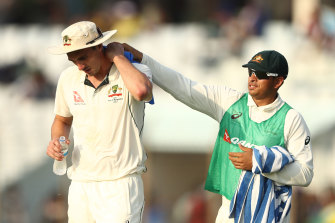
Cummins and teammate Usman Khawaja have had deep chats about religion. “He’s a very humble character,” says Khawaja. “He treats people nicely.”Credit:Getty Images
When he returned from a back injury to the Test team against India in Adelaide in December 2018, other players and staff noticed Cummins now had the capacity to call things out he didn’t like. Some boorish dressing-room language, for instance. “I’ve got a little bit stronger on a few things,” he concedes. “I love the guys who I play alongside; it isn’t just a hobby or even a job.
We spend more time with this group than we do with our partners at home. So I don’t like problems festering. I don’t want to spend 70 per cent of my life on tour in an environment I’m not totally comfortable with.
“The non-negotiable for teams is that we want to bring a range of diverse thinking and people together. At times that’s been squandered, or you’ve got 30 alpha males on a tour, so there’s going to be times when someone doesn’t fit that kind of mould, and they might feel ostracised.”
There is some crossover with Cummins’ other interests. Driven by his parents’ involvement in charitable activities – to this day, they are part of a local feed-the-homeless program every Wednesday night – Cummins has built relationships with UNICEF, climate change initiatives and the anti-racism campaign Reflect Forward. He’s also taken by how “doing things the right way” can now be a competitive advantage. “It’s been a real inflection point in the past couple of years, where if you try to do the right thing, it’s been great to see companies that are rewarded,” he says. “I love seeing the socially conscious companies win. It all comes from consumers and new generations demanding that things are done right.”
“Those couple of per cent gains in performance don’t come from skill acquisition or technique.”
Two leaders Cummins regards highly are England’s Eoin Morgan and the former New Zealand skipper Brendon McCullum. He’s worked with both for the Kolkata Knight Riders franchise in the Indian Premier League. What the trio share is a belief that, at the top, improvements come from relieving pressure: something that did not take place to a great-enough extent in South Africa in 2018, nor in performances in some more recent series, such as last summer’s home matches against India.
“Those couple of per cent gains in performance don’t come from skill acquisition or technique,” Cummins says. “If we’ve got a young guy who’s come into the side, I don’t think senior players or coaches changing his technique and telling him exactly how to bowl or bat are going to have as much of a positive impact as if he feels welcome, and he’s encouraged to do all the things that got him there. If we can relieve a little bit of that pressure everyone feels playing professional sport in front of millions of people, that’s where the biggest value is to be had.”
These were some of the themes tackled in the unprecedented recent meeting between Cummins, the then Test captain Tim Paine and white-ball captain Aaron Finch with CA’s chief executive Nick Hockley and the then chair Earl Eddings, to discuss the team environment. On the evidence of the recent T20 World Cup, at which victory was accompanied by coach Justin Langer declaring the squad “embraced fun”, the environment is now being moulded in a more relaxed, player-driven manner than during the past three years.
“The most important part of my role is to look after our players and listen to them, make sure they’re heard, so I tried to do that as best as I could,” Cummins says of that meeting. “Everyone likes everything out there, and no secrets, and I thought it was really important that we got together and put it all on the table.”
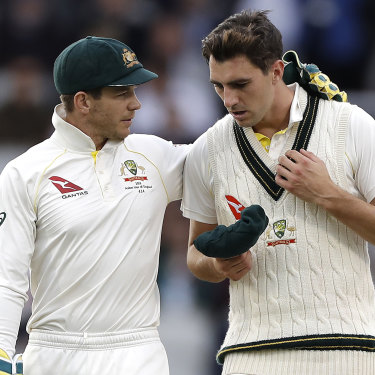
With Tim Paine, whom Cummins replaced as captain.Credit:Getty Images
The question of whether a fast bowler could be Australian Test captain was answered partly by the way Tim Paine ended conservatism about giving the same role to a wicketkeeper. Certainly, the former selection chair Trevor Hohns thinks so. “Over the last 12 to 18 months we’ve shown our hand a little bit with Pat,” Hohns says. “As a fast bowler, who knows whether he’s going to be able to play every game. The way to get around that, of course, is to have a good deputy to step up if Pat were to get injured. That deputy would have to be somebody who could take over as captain, not just somebody who is a good second-in-command.” That deputy is Steve Smith, who as a former captain will be able to do exactly that.
Cummins got his first glimpse of captaincy with NSW in one-day cricket last summer. “It’s amazing how you’re there doing your shoelaces up and you’ve got 10 different people there: the bowling coach coming to give you a little tip, or the physio comes to say someone is going to be right to play. You’re just in demand.”
Having lived through the ball-tampering scandal and a cultural review of the Australian men’s team, Cummins appreciates the wider significance of captaincy, but also counsels consideration of the relative ages of athletes; similar, he says, to those of young musicians or actors, as opposed to corporate CEOs.
“A captain does have a lot of responsibility. You’re going to have 10 different personalities, ages, backgrounds; you’ve got to have some kind of range to be able to get the best out of all those players. You’re also looking after a wider support crew of maybe 15 to 20 people on tour, all older than you, more life experience, experts in different fields. So you do need to have a bit more breadth than purely cricket.”
Khawaja believes Cummins’ humility will make him a strong leader. “Patty has always been really good at that, he’s been open and welcoming to different people,” he says. “His parents are lovely, too; you can tell he’s come from a good upbringing. I’ve seen the way he treats other people, you can just see it straight away. He’s a very humble character, he treats people nicely.”
One of the hardest things for any bowler-captain is the need to think outside themselves even when exhausted. Cummins spoke gracefully to the travelling media about half an hour after Ben Stokes’ 2019 Headingley heist in Leeds, in which Australia lost a supposedly unlosable Test match, even as the dressing room remained in a state of shock. But I remind him of how exasperated he appeared on the final evening of the Old Trafford Test in Manchester a few days later, when his last involvement in the match consisted of a volley of bouncers at the England tail.
“I was super-frustrated,” he concedes. “I felt like Headingley got away from us. I thought we should’ve won at Lord’s, too, so I remember thinking, ‘Surely, we can’t have another one that slips away.’ It was an amazing feeling when we finally reclaimed the Ashes by winning at Old Trafford, but from the time that match finished until the fifth and final Test at the Oval, I was spent. I put everything into that Test.
“You see people win premierships in AFL or NRL and they go on a two-week bender. Whereas in cricket you come to the end of a Test series and everyone’s ready to go home and sleep for a few days.”
Those moments are the biggest question about whether you could be a good Test captain, I say, because that’s how tiring fast bowling can be. “That is one of them, and the other question is just about bowling myself,” he replies. “Do you have a good enough feel for how much you need to bowl or not bowl? But they’re problems that can be solved. [As captain], I won’t be out there alone. If I was exhausted and knew I wasn’t going to be thinking clearly enough and someone else had more to offer, I’d be very comfortable just hand-balling to them at times.”
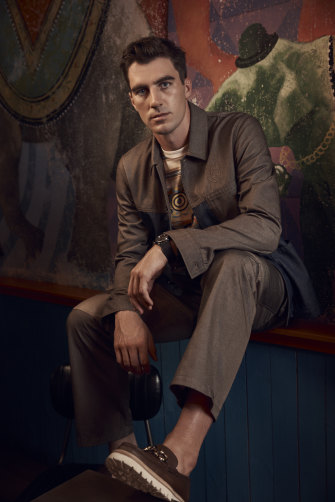
“If we can relieve a little bit of that pressure everyone feels playing professional sport in front of millions of people, that’s where the biggest value is to be had.” Credit:Damian Bennett
As we speak, Cummins has one eye on our chat window and one on the baby monitor of his son, Albie. Albie was born on October 8, only a day later than the couple and Cricket Australia had mapped out in their summer schedule six months beforehand. Well-planned as this was, the new parents then still had the wrenching experience of Cummins’ rapid departure overseas to the United Arab Emirates for the T20 World Cup.
“I’m really glad he was there for the birth because I don’t think I could’ve done it without him,” Becky enthuses. “However looking back, him leaving the day after we got home from hospital was the most ridiculous, hardest thing … it was terrible timing. But I wouldn’t have had it any other way; he got to be there, of course, and you’ve got to do what you’ve got to do.”
“I’m really glad he was there for the birth … [But] him leaving the day after we got home from hospital was the most ridiculous, hardest thing.”
Parenthood is the most fundamental way in which Cummins defines himself, apart from cricket. As Australia’s next Test captain, he knows he’ll be missing a lot of treasured private moments to create many more public ones.
When Becky explains she’s been “holding up” Albie to mimic the opening scene in The Lion King while listening to the soundtrack, all of us laugh, as Cummins exclaims, “I didn’t know that.” Then his tone changes to something softer, and more fatherly. “I think I need to get home,” he says.
To read more from Good Weekend magazine, visit our page at The Sydney Morning Herald, The Age and Brisbane Times.
The best of Good Weekend delivered to your inbox every Saturday morning. Sign up here.
Most Viewed in Sport
"Sporty" - Google News
December 04, 2021 at 04:22AM
https://ift.tt/3rvrvGd
From high-school ‘sporty-geek’ to Test captain: the rise of Pat Cummins - The Sydney Morning Herald
"Sporty" - Google News
https://ift.tt/39Axe1U
Shoes Man Tutorial
Pos News Update
Meme Update
Korean Entertainment News
Japan News Update
Bagikan Berita Ini














0 Response to "From high-school ‘sporty-geek’ to Test captain: the rise of Pat Cummins - The Sydney Morning Herald"
Posting Komentar